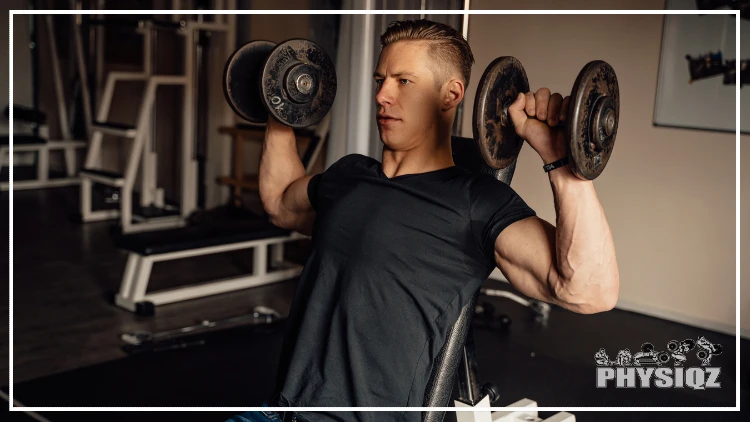
When deciding between the Arnold press vs shoulder press, weightlifters frequently debate which exercise is more effective for sculpting broad shoulders and achieving the desired V-taper physique.1
For this reason, we’ll cover when to use each, the differences in movements, muscles worked, how to perform them with proper form, their pros and cons, and explain the 10 muscles worked better in the Arnold press as well as the muscles worked in each.
Arnold Press vs Shoulder Press: What’s the Difference in Movement?
While both exercises target the shoulder muscles and involve a pressing movement using dumbbells, there are some differences that arise due to a subtle change in variation and technique of the traditional press.
The Arnold press, one of the compound shoulder exercises, has the lifter slightly twist the dumbbells as they raise them over their heads and this is due to the starting position where the palms are in a pronated position facing the torso.
This movement happens in one motion and at the top position, the palms are now facing outward (supinated) as they would in a traditional press.
They are similar in that both these exercises can be done sitting and standing and also employ the use of dumbbells.
As a result of this rotation, there is a significant impact in regards to range of motion (the extent through which a muscle and /or joint can be moved in a plane of motion), muscle recruitment and the time the muscles stay under tension—effectively combining the movement as both a shoulder press and a lateral raise movement.
Since the elbows are moved inwards and palms rotated through the lift, all three heads of the deltoid muscles will be hit—front, rear and side delts making it a viable exercise for those with bad shoulder genetics.
How To Perform an Arnold Press With Perfect Technique
The Arnold press can be done both sitting and standing as with the standard shoulder press and the setup is similar.
- Grab a pair of dumbbells and sit down on a bench with feet firmly planted on the floor, and have the dumbbells in front of the torso at face height while the palms are facing the body. The elbows are slightly tucked here but not excessively.
- Brace the abs, lift the chest and ensure that the shoulders are retracted.
- Initiate the movement while pressing the weight up, but simultaneously rotating the palms such that they are now facing away from the body.
- At the top of the movement and during the lockout, the palms are now facing away from the lifter as they would be with a conventional shoulder press. It is recommended to have the elbows flare out slightly while pushing upwards to have the dumbbells wider at the top.
- Complete the rep by lowering the weight while simultaneously rotating the palms and have them end up at the end position facing the body once again.
- The weights should be lowered (eccentric) under control to maximize hypertrophy (muscle growth).
How To Do a Shoulder Press With Great Form
Shoulder presses can also be done while standing or sitting on a bench.

Source: MRBIG_PHOTOGRAPHY via Canva.com2
- Grab a pair of dumbbells and lift them such that the upper arms are almost parallel to the ground. Ensure the core and abs are engaged, chest up and maintain the shoulders to be in a retracted and pulled back position.
- Press the dumbbells up following an arc shape bringing the weights together above the head and straighten the arms. Do not lock the elbows forcefully or push the weight in front of you – it should go directly overhead and almost as if it’s “slightly” behind you.
- Slowly lower the dumbbells back to the starting position and repeat.
Arnold Press Muscles Worked vs Shoulder Press Muscles Worked
Both the Arnold press vs shoulder press work similar muscles with a slight variation in the muscles worked and focus due to the rotation that takes place in the Arnold press—however, both presses have the shoulder (deltoid muscles) at the heart of their workout.
Since the shoulder muscle is composed of front, lateral (side) and posterior (rear) muscles, each of these components get a varying degree of activation in either exercise.
Arnold Press Muscles Worked
These 10 Arnold press muscles worked better are an indication and testament to the efficiency of this exercise:
#1 Anterior (Front) Deltoids—By virtue of being a pressing exercise, the Arnold press engages the front delts which are the primary movers of the movement.
#2 Lateral (Side) Deltoids— Due to the hybrid nature of the Arnold press, combining a lateral raise and shoulder press, the lateral delts are actively engaged in the movement.
#3 Posterior (Rear) Deltoids—Rear deltoids are greatly activated in the Arnold press due to the rotation movement and abduction of shoulders (when arms are lifted out to the side) at the bottom end of the movement.
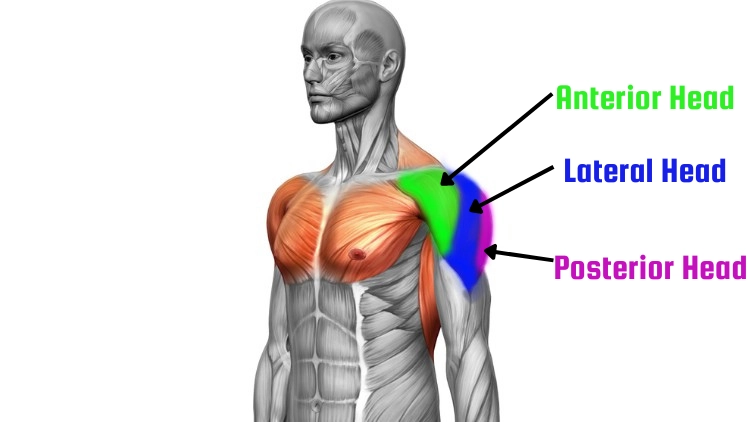
Source: Science Photo Library via Canva.com3
#4 Triceps— The triceps muscles main responsibility lies in extending the arms during the pressing movement. They will also indirectly help the lifter achieve lock out at the top of the movement and as they are one of the bench press muscles worked, the Arnold press can help carry over to the bench press.
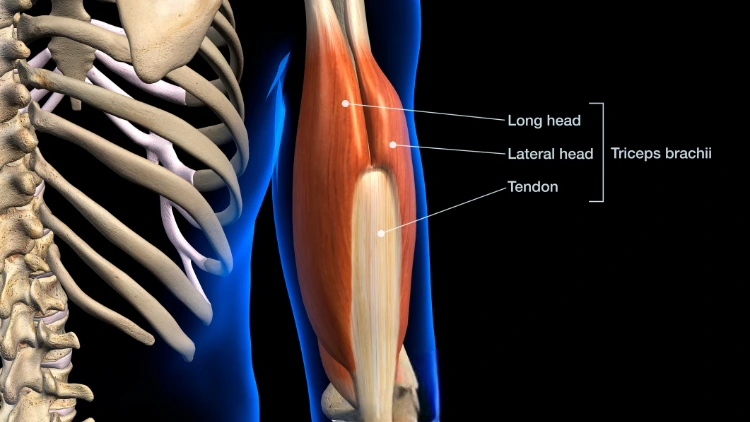
Source: Hank Grebe via Canva.com4
#5 Pecs—Pecs play a minor role in the Arnold press by helping to rotate and abduct the arms.
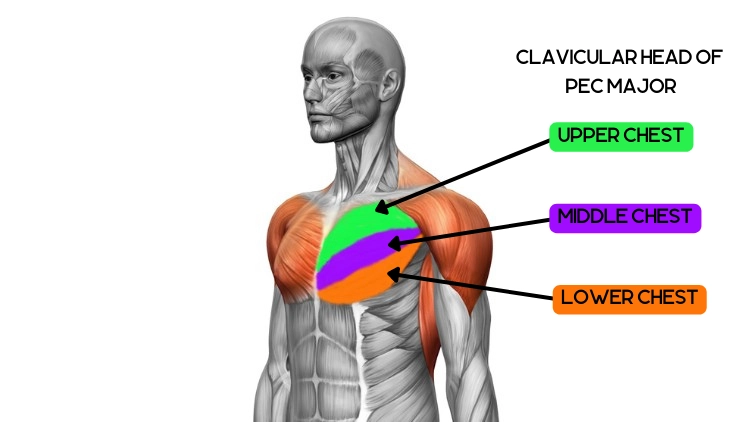
Source: Science Photo Library via Canva.com5
#6 Traps— Running from the base of the neck to the upper back, the traps are highly activated because they will aid with mobility in regards to the head, neck, arms, torso and shoulders.
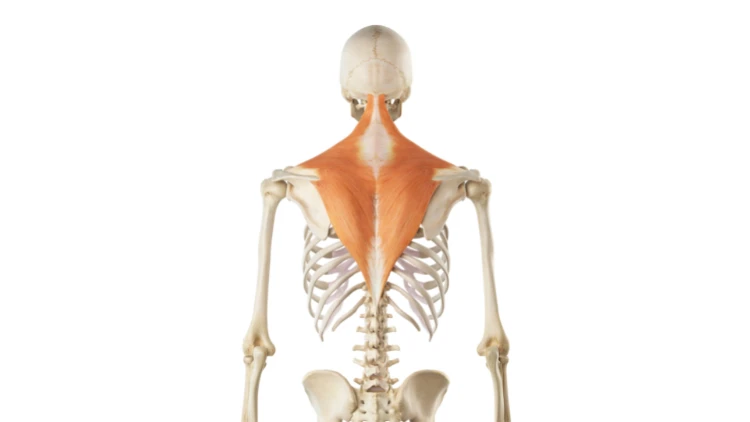
Source: Science Photo Library via Canva.com6
#7 Serratus Anterior— This muscle is fan shaped and is located at the 1st and 8th or 9th ribs and its main function is to retract the shoulder blades.
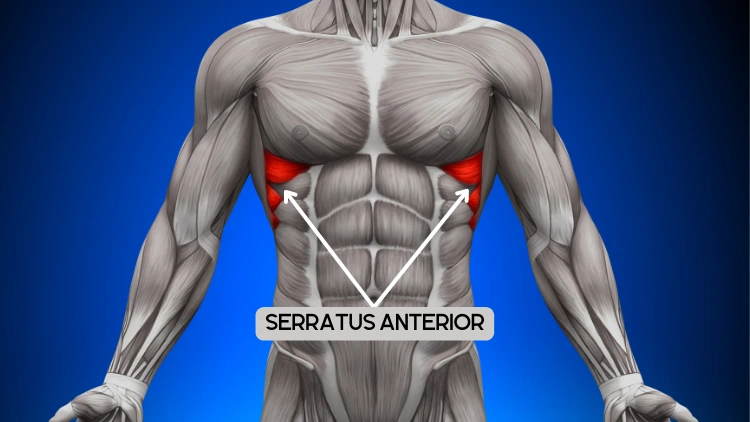
Source: decade3d via Canva.com7
#8 Rotator Cuff— The rotator cuff is composed of 4 muscles namely: supraspinatus, teres minor, infraspinatus and subscapularis and it is responsible for providing stability to the shoulder joint since its anatomy of having a small glenoid cavity and a large head that is spherical makes it very unstable.8
Rotator cuff muscles also control the fine actions during the pressing movement.
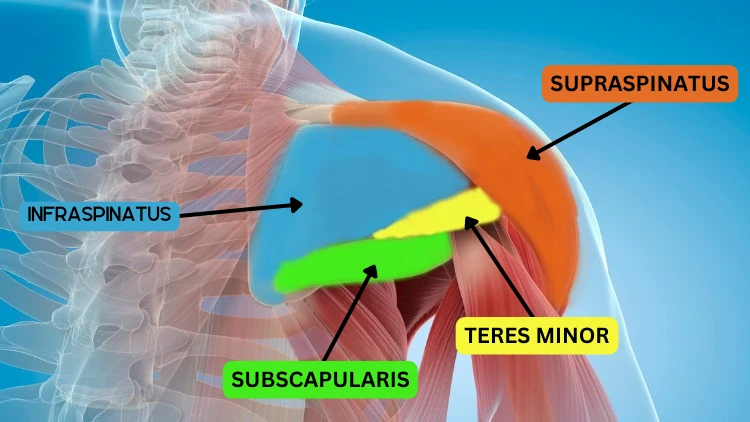
Source: Science Photo Library via Canva.com9
#9 Abdominal Muscles—When the Arnold press is performed standing, the abdominal muscles help in providing balance and stability to the torso.
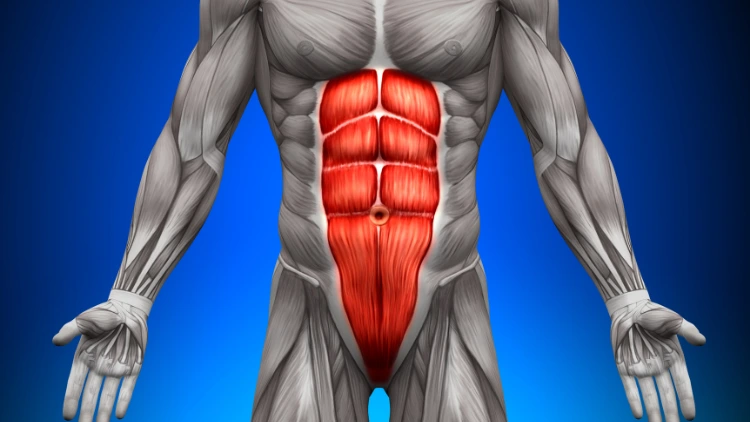
Source: decade3d via Canva.com10
#10 Glutes—The glutes are engaged only when the exercise is done in a standing position helping stabilize the body; they are often squeezed and activated during the exercise.
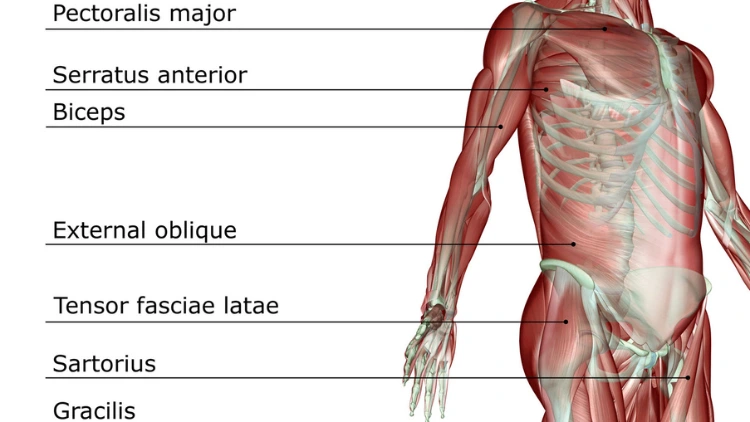
Source: Science Photo Library via Canva.com11
Shoulder Press Muscles Worked
Shoulder press works the following muscles:
Front Deltoids—The front deltoids are the primary movers of the shoulder press and are the agonist muscle, providing the main force of the movement. Shoulder press elicits over 30% front deltoid activation when compared to other exercises such as the bench press.12
Lateral and Rear Deltoids—While these two heads are also engaged in the shoulder press, they do not have a pronounced role as they have in the Arnold press, and work only as stabilizers for the movement.
Triceps—The triceps have the role of extending the elbows during pressing and helping in the lockout. This compound movement can help those with bad tricep genetics overcome their genetic inadequacies.
Pecs—Pecs play a minor role in the shoulder press by helping to rotate and abduct the arms.
Traps—As with the Arnold press, the traps help with head, neck, arms, torso and shoulders mobility.
Rotator Cuff—These serve to stabilize the shoulder joint and control the finer and intrinsic movements.
Abdominal Muscles—When the shoulder press is performed standing, the abdominal muscles help in providing balance and stability to the torso.
Glutes—Glutes are engaged only when the exercise is done in a standing position, helping to stabilize the body; they are often squeezed and activated during the exercise.
Arnold Presses Emphasizes & Works 2 Muscles Better—The lateral and posterior deltoids are highly activated in this movement due to the rotational aspect.
Shoulder Presses Emphasizes—Front deltoid muscle is worked better in this movement since they are the main and primary movers providing the majority of the force for the movement.
Which Is Better for Overall Shoulder Development: Arnold Press or Shoulder Press?
Lifters often have different goals for training their shoulders, but for the most part, it boils down to two reasons—training for muscle growth and strength. Each type of shoulder exercise has some advantages over the other when it comes to accomplishing these goals.
Muscle Growth—Arnold press movement was invented to elicit hypertrophy and is a branch from the bodybuilding sport.
The shoulder press will build bigger muscles especially since more load can be carried, but the Arnold press is specifically oriented towards hypertrophy, particularly because it results in increased time under tension and a larger ROM, placing it an advantage in spite of not being able to go heavy on it.
Time under tension (time under which a muscle is under load and contraction) has been shown to increase muscle growth.13
Strength—The somewhat awkward starting position and rotation of the dumbbells in the Arnold press means that you can’t press more than you could in the shoulder press.
Shoulder presses can allow the lifter to go heavy, which means they can get stronger from doing the workout, which makes it the clear winner for muscle strength.
Pros & Cons of Shoulder Press vs Arnold Press (Comparison of Arnold Press vs Overhead Press)
Whether comparing the Arnold press vs shoulder press, both shoulder exercises offer distinct advantages and disadvantages based on factors such as muscle activation, range of motion, and lifting capacity.
Pros & Benefits
Arnold presses have a greater ROM and increased muscle activation while shoulder presses will typically allow the lifter to go heavier. Here are the pros of each style of press.
Pros of the Arnold Press:
- Increased Range of Motion—Allows for an increased range of motion (ROM) due to having elements of both the shoulder press and the lateral raise. In addition to this, the weights are lowered to the chin level which also plays a part in the increased ROM.
Training through a full and/ or increased ROM produces an increase in muscle activation and subsequent muscle growth.14
- Greater Muscle Activation—Arnold press provides the lifter with a chance of greater muscle activation since the muscles are stretched longer. It places emphasis on not only on the front delts as the shoulder press does, but also the side and rear delts due to the rotation making for a more complete and efficient exercise.
- Mind Muscle Connection—A lifter is not able to go very heavy on the Arnold press due to the additional stress placed on the forearms forcing them to go light; this is both a pro and a con. Because the lifter is forced to go lighter, they can increase their mind muscle connection when engaged in the exercise.
Mind muscle connection is feeling or paying mind to the muscle as it is being activated and has been proven to increase engagement of the target muscle, resulting in increased muscle growth.15
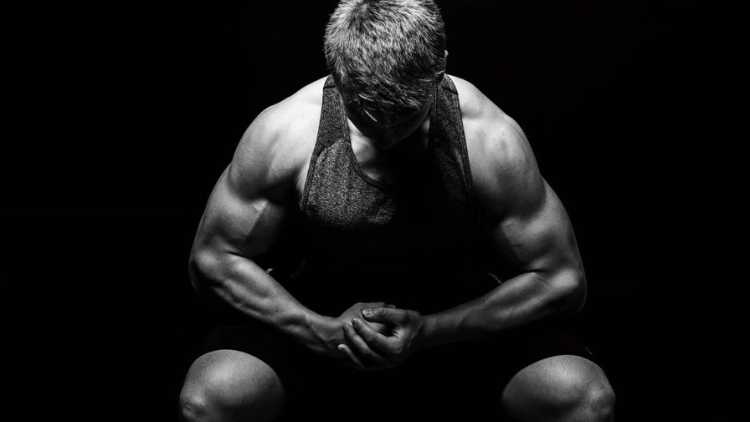
Source: NalaDesignStudio via Canva.com16
Pros of the Shoulder Press:
- Focus on the Front Delts—The shoulder press done while standing or sitting is a staple for bodybuilders because it is excellent at targeting the front deltoids.
- Can Lift Heavy—Due to the simplicity and straightforward nature of the movement, lifters can go heavier on shoulder presses than they would on the Arnold press which can help elicit muscle growth. This lack of complexity makes it easier to learn especially with beginners new to weights.
- Easy on the Shoulders—Due to the lack of rotation, this exercise puts less stress on the shoulders and the risk of shoulder impingement thus reducing risk for injury.
Cons & Downsides
Both exercises have certain disadvantages compared to the other, such as weight restrictions on the Arnold press and less muscle activation in the shoulder press.
Cons of the Arnold Press:
- Can’t Lift Heavy—The rotational aspect on the Arnold press makes it more challenging to add heavy weight because this carries the risk of placing stress on the shoulder joint which could pave the way for injury and simply not worth it.
- Impingement of the Shoulder Joint—Arnold press combines two movements namely flexion of the joint and extension which happens due to rotation. Impingement occurs when the rotator cuff rubs against the arm (humerus bone) and the outer edge of the shoulder socket—due to this, there is friction and a resulting irritation and pain which can hinder the ROM and efficiency of the movement.17
- Painful Wrists—Again, the rotational aspect of the Arnold press places additional and undue stress on the wrist joint more than shoulder presses. Using wrist wraps can help alleviate this problem.
A lifter can work on developing their forearm and grip strength, which can also make their choice easier when choosing between hook grip vs mixed grip for deadlifts, due to having improved grip.
Cons of the Shoulder Press:
- Challenge in Setting Up the Weights—When a lifter is advanced and is lifting heavy on the shoulder press, it is usually a challenge to get the dumbbells to the starting position. They can be placed into the correct position using the legs and /or ‘cleaned’ to the shoulders.
A barbell press from a rack is much easier to accomplish this set up.
- Doesn’t Hit All Heads—The shoulder press is not efficient at hitting the other heads of the delts other than the front. Rear and side delts will require additional exercises to be properly activated and targeted.
Should I Flare My Elbows or Keep Them in Front of Me During Arnold Presses & Shoulder Presses?
During the Arnold press, it is recommended to flare out the elbows due to the rotational nature of the movement. This will allow the dumbbells to be wider at the top of the movement.
The converse is true for the shoulder press. Elbows should be placed in front of the body but pointed to the sides.
When the elbows are out on the sides, the side delts are engaged more and when the upper arms are in front of the torso, the front delts are activated more.
However, in the conventional barbell shoulder press, the elbows should not be flared, rather they should stay angled in and/or tucked in to allow more focus to be placed on the shoulders, upper pecs and triceps. When the elbows are flared, the pecs and triceps are less activated and can lead to unnecessary shoulder stress.
When To Use the Arnold Press & When To Use the Shoulder Press
Deciding between the Arnold press and shoulder press relies on the lifter’s training objectives, their level of experience, whether they’re a novice or seasoned lifter, and the specific muscles they’re targeting—both press variations offer features suitable for different individuals.
Use the Arnold Press for Muscular Size & Hypertrophy—For muscle size and hypertrophy, the Arnold press is ideal because the movement has an orientation towards muscle growth by providing increased time under tension and increased range of motion.
These two are stimulants for muscle growth in spite of not being able to go heavy on Arnold press.
In addition, Arnold presses increase the mind muscle connection which significantly increases muscle growth.
Use the Shoulder Press To Get Stronger & More Powerful—Shoulder presses allow for a simpler movement that places less stress on the shoulder joint which means that lifters can go heavy on the movement. Therefore, it is ideal for enhancing strength and power.
Use the Shoulder Press as a Beginner—The regular shoulder press is a simpler movement to perform and therefore easier to learn for the beginner who is new to weights and strength training, and is thus a better option.
Due to the rotating nature of the Arnold press, it is more suited to advanced lifters who are more adept at technique and form.
Use the Arnold Press for Lateral Deltoid Development—Since the Arnold press combines the motion of a shoulder press and lateral raise, they are better at targeting and activating the lateral (side) deltoids than the conventional dumbbell press can.
Use the Arnold Press for the Posterior Deltoid— The Arnold press is most suited for posterior (rear) deltoid development due to the rotation and the abduction of the shoulders at the bottom part of the movement resulting in an increased focus on the rear delts.
When debating what exercise is best for achieving a lifter’s training goals, whether to get cannonball shoulders or simply increase upper body strength, the choice boils down to two exercises. This will ultimately come down to choosing between Arnold press vs shoulder press and these 10 Arnold press muscles worked better to prove that it is an efficient exercise to completely grow and strengthen the upper body.
Frequently Asked Questions
Which Is More Effective: The Standing Version of the Arnold Press or the Seated Variation?
It depends on the training goals. When done standing, they will help build core strength and are ideal for individuals who are engaged in exercises that require functional strength like bodybuilders, powerlifters, strongman and crossfit.
However, when done seated, they are better for hypertrophy since they isolate the shoulders better.
Is Dumbbell or Barbell Shoulder Presses Better?
It depends on what the lifter is looking for with the pressing movement. For individuals, who are looking to increase upper body strength and overall mass, then the barbell is the preferred choice since the lifter can go heavier.
However, lifters looking for more defined and rounded shoulders, dumbbells are the way to go to appease aesthetic reasons.
How do Arnold Press, Shoulder Press, Military Press, and Overhead Press differ from each other?
The Arnold press strictly uses a set of dumbbells and involves the lifter rotating the dumbbells starting with palms facing inwards towards the torso, and ending up facing outwards at the top of the movement. The military press has the lifter place the feet together in restrictive posture simulating army men, with the aim of maintaining tension in the whole body.
However, in the overhead press, the individual can maintain a wider stance that has the feet typically shoulder width apart. The shoulder press is done sitting using dumbbells or using a machine.
How Frequently Should I Do Overhead Press Exercises?
Lifters may start doing overhead press 3 times a week and spend a few weeks before they can increase this to 5 times a week—eventually training them every day. To counteract all the pushing, aim to do some pulling exercises such as deadlifts and bent over rows similarly when performing pull up vs push up routines that complement each other.
How Heavy Can You Go on the Arnold Press?
The Arnold press is not an exercise that lifters should go heavy due to the stress it places on the shoulder joint. However, it is possible to train heavy, especially for advanced lifters who have mastered the technique and they can train in the 8-12 rep range.
These should be worked in controlled movements up to technical failure.
What Width Should the Arms Be in the Arnold Press?
This depends on the individual’s anatomy due to differences in shoulder mobility and length of the limbs. Typically, the lifter should strive to maintain the arms parallel to each other and at a 90 degree angle (perpendicular) to the ground.
A narrow stance will result in engaging the front of the shoulders excessively, and too wide, the dumbbells may feel like they may topple to the sides.
References
1Alesia Kozik. “Man in Black T-shirt Holding Black Dumbbell.” Canva. Accessed 13 April 2023. <https://www.canva.com/photos/MAEaDayQ1Ts-a-man-doing-a-dumbbell-shoulder-press/>
2MRBIG_PHOTOGRAPHY. “Dumbbell Shoulder Press.” Canva. Accessed 13 April 2023. <https://www.canva.com/photos/MAEEh-yoeao-dumbbell-shoulder-press/>
3Science Photo Library. “The muscles involved in standing biceps curl. The stabilizing muscles are highlighted.” Canva. Accessed 12 April 2023. <https://www.canva.com/photos/MADmTGwAFbo-the-muscles-involved-in-standing-biceps-curl-the-stabilizing-muscles-are-highlighted-/>
4Hank Grebe. “Labeled Anatomy Chart of Shoulder, Elbow and Triceps Muscles in Skeleton on Black Background.” Canva. Accessed 12 April 2023. <https://www.canva.com/photos/MAEJnzTxmJU-labeled-anatomy-chart-of-shoulder-elbow-and-triceps-muscles-in-skeleton-on-black-background/>
5Science Photo Library. Canva. Accessed 13 April 2023. <https://www.canva.com/photos/MADmTGwAFbo-the-muscles-involved-in-standing-biceps-curl-the-stabilizing-muscles-are-highlighted-/>
6Science Photo Library. “”Human trapezius muscles.” Canva. Accessed 13 April 2023. <https://www.canva.com/photos/MADmTLHptgU--human-trapezius-muscles/>
7decade3d. “Serratus Anterior – Anatomy Muscles.” Canva, 20 April 2019. Accessed 13 April 2023. <https://www.canva.com/photos/MAC_UoPgDPM-serratus-anterior-anatomy-muscles/>
8Maruvada, S., Madrazo-Ibarra, A., & Varacallo., M. (2022, March 31). Anatomy, Rotator Cuff. Retrieved 2023, from <https://www.ncbi.nlm.nih.gov/books/NBK441844/>
9Science Photo Library. “”Shoulder muscles.” Canva. Accessed 12 April 2023. <https://www.canva.com/photos/MADmTDg8VA4--shoulder-muscles/>
10decade3d. “Abs – Anatomy Muscles.” Canva. Accessed 12 April 2023. <https://www.canva.com/photos/MADerFwn3js-abs-anatomy-muscles/>
11Science Photo Library. “An anterolateral view (right side) of the muscular system.” Canva. Accessed 13 April 2023. <https://www.canva.com/photos/MADmTJZdYk4-an-anterolateral-view-right-side-of-the-muscular-system-/>
12Yuri A. C. Campos, J. M.-M. (2020, October 31). Different Shoulder Exercises Affect the Activation of Deltoid Portions in Resistance-Trained Individuals. Retrieved 2023, from <https://www.ncbi.nlm.nih.gov/pmc/articles/PMC7706677/>
13Nicholas A Burd, R. J. (2011, November 21). Muscle time under tension during resistance exercise stimulates differential muscle protein sub-fractional synthetic responses in men. Retrieved 2023, from <https://www.ncbi.nlm.nih.gov/pmc/articles/PMC3285070/>
14Brad J Schoenfeld, J. G. (2020, January 21). Effects of range of motion on muscle development during resistance training interventions: A systematic review. Retrieved 2023, from <https://www.ncbi.nlm.nih.gov/pmc/articles/PMC6977096/>
15Joaquin Calatayud, J. V. (2016, March). Importance of mind-muscle connection during progressive resistance training. Retrieved 2023, from <https://pubmed.ncbi.nlm.nih.gov/26700744/>
16NalaDesignStudio. “Man Muscles Bodybuilder.” Canva, 13 December 2011. <https://www.canva.com/photos/MAFDPBkFmiw-man-muscles-bodybuilder/>
17Ludewig, P. M. (2011, February). Shoulder Impingement: Biomechanical Considerations in Rehabilitation. Retrieved 2023, from <https://stacks.cdc.gov/view/cdc/33180>